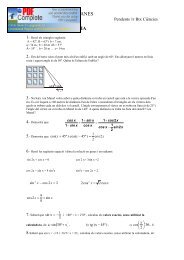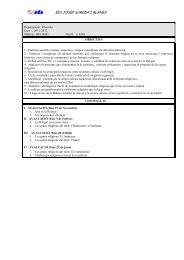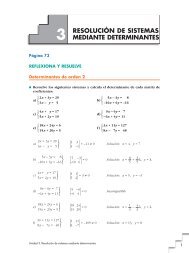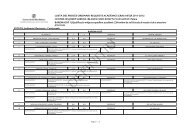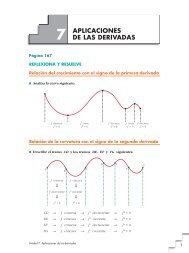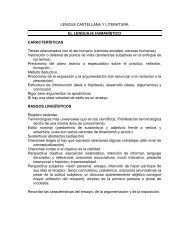Tema 6: Derivadas. Técnicas de derivación
Tema 6: Derivadas. Técnicas de derivación
Tema 6: Derivadas. Técnicas de derivación
Create successful ePaper yourself
Turn your PDF publications into a flip-book with our unique Google optimized e-Paper software.
°§§¢§£UNIDAD6En x = 2:lím f (x) = lím (3x – 1) = 5x 8 2 – x 8 2 –lím f (x) = lím (x 2 + 1) = 5x 8 2 + x 8 2 +f (2) = 5f (x) es continua en x = 2.Por tanto, f (x) es una función continua.Si x ? 2: f (x) es <strong>de</strong>rivable y su <strong>de</strong>rivada es:° 3 si x < 2f'(x) = ¢£ 2x si x > 2a) f'(1) = 3; f'(3) = 6b) f'(2 – ) = 3f'(2 + ) = 4°¢£no coinci<strong>de</strong>n24 Esta es la gráfica <strong>de</strong> una función y = f (x).Calcula, observándola:f'(–1), f'(1) y f'(3)¿En qué puntos no es <strong>de</strong>rivable?2–2 2 4• En x = –1, la recta tangente a f es horizontal; su pendiente es 0. Por tanto,f'(–1) = 0.• En x = 1, f es una función constante. Luego f'(1) = 0.• En x = 3, f es una recta que pasa por los puntos (2, 1) y (4, 5). Calculamos supendiente:5 – 1m = = 2. Por tanto, f'(3) = 2.4 – 2• No es <strong>de</strong>rivable en x = 0 ni en x = 2, porque en ellos observamos que:f'(0 – ) ? f'(0 + ) y f'(2 – ) ? f'(2 + )25 ¿Cuántos puntos que no tengan <strong>de</strong>rivada hay en la función y = |x 2 + 6x + 8|?x 2 –6 ± √36 – 32 –6 ± √4 –6 ± 2 x = –2+ 6x + 8 = 0 8 x = = =22 2 x = –4° x 2 + 6x + 8 si x < –4 ° 2x + 6 si x < –4§§y = ¢ –x 2 – 6x – 8 si –4 Ì x Ì –2 y' = ¢ –2x – 6 si –4 < x < –2§§£ x 2 + 6x + 8 si x > –2 £ 2x + 6 si x > –2La función es continua, pues es el valor absoluto <strong>de</strong> una función continua.Unidad 6. <strong>Derivadas</strong>. <strong>Técnicas</strong> <strong>de</strong> <strong>de</strong>rivación21



